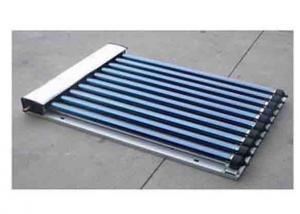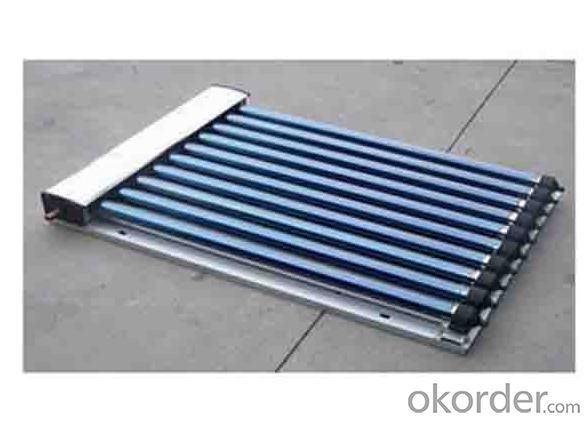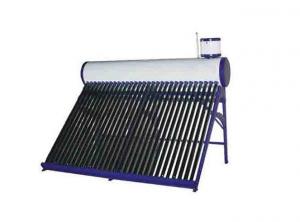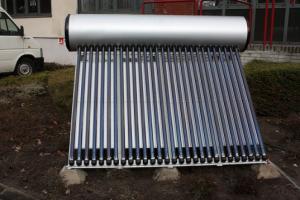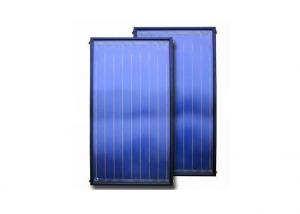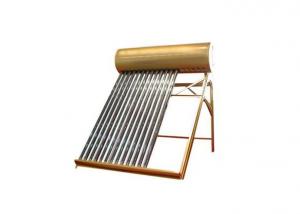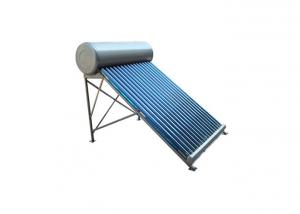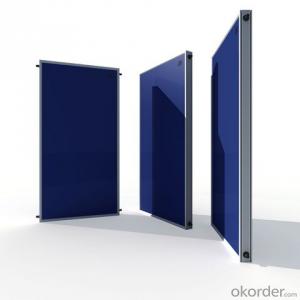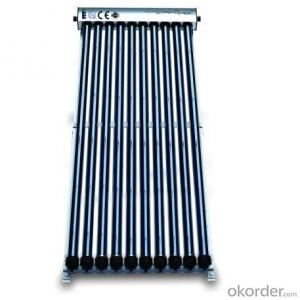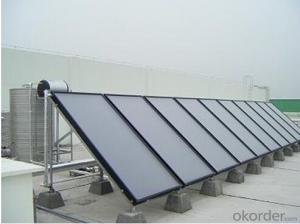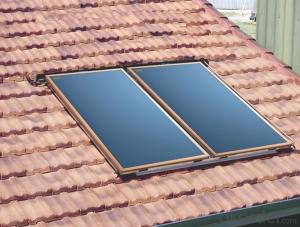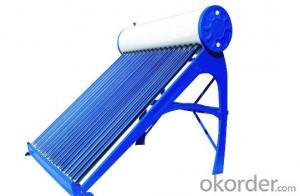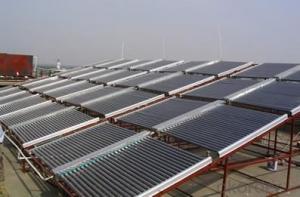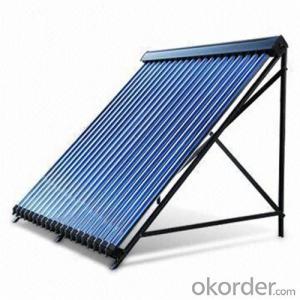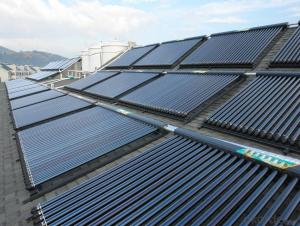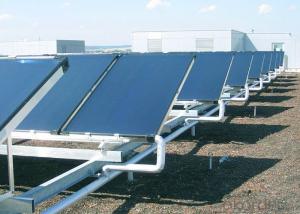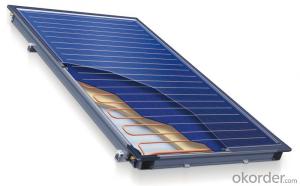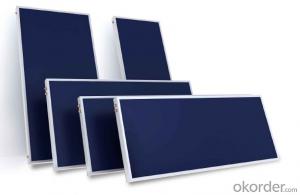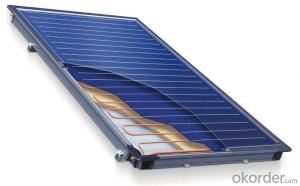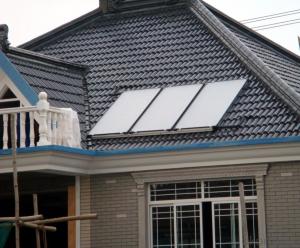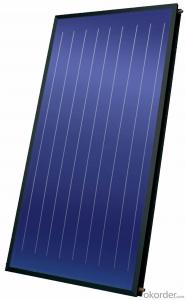Plastic Solar Collectors Split Pressurized Solar Water Heater
- Loading Port:
- China Main Port
- Payment Terms:
- TT or LC
- Min Order Qty:
- 2 Sets set
- Supply Capability:
- 180000 Sets per Year set/month
OKorder Service Pledge
OKorder Financial Service
You Might Also Like
*Heat collector
*Storage tank
*Working station kit
*Have own factory of vacuum tube
Working principle:
1) When the temperature of the heat collector reaches the set value, the controller will make shall the circulation pump work automatically.
2) The circulation pump makes heat-conducting liquid circulate automatically.
3) The heat-conducting liquid transfers heat to water by the heat exchanger in the tank.
4) In case the temperature of the circulation pump does not reach the set value, the circulation pump will be shut automatically.
5) In case the temperature of the tank does not reach Tm ax, then start the auxiliary heating device.
Feature:
*Collector separates with storage tank. The tank can be put in any place of house. And the collector can be put on the inclined roof or flat place.
*Module design, arbitrary combination, harmony with the building perfectly;
*Intelligent control and automatic operation;
*Anti-freeze: No water inside the tubes when it works.
*The system controller has the anti-freezing function is that the temperature circulation will operate while it reaches the fixed temperature.
*Multifunction: Bathing, washing, domestic heating etc;
*Work at anytime and enjoyable.
Structure:
Model No: 100L 150L 200L 300L
- Q: Can solar collectors work in cloudy or winter weather?
- Yes, solar collectors can still work in cloudy or winter weather, although their efficiency may be reduced. While direct sunlight is ideal for maximum energy production, solar collectors can still capture and convert diffuse sunlight and indirect light into usable energy. Some advanced solar technologies are specifically designed to perform well in low light conditions, making them suitable for cloudy or winter weather.
- Q: Can solar collectors be used for drying gardening tools?
- Yes, solar collectors can be used for drying gardening tools. Solar collectors, such as solar panels or solar thermal collectors, harness the sun's energy to generate heat. This heat can be utilized to dry gardening tools effectively. To use solar collectors for drying gardening tools, the tools can be placed in an open area exposed to sunlight or inside a greenhouse equipped with solar collectors. The solar collectors will absorb sunlight and convert it into heat, which will then warm up the surrounding air, creating a drying effect. The advantage of using solar collectors for drying gardening tools is that it is an environmentally friendly and cost-effective method. By utilizing solar energy, no additional energy or fuel is required, reducing dependence on non-renewable resources. Additionally, using solar collectors for drying purposes can save on energy costs in the long run. It is important to note that the effectiveness of solar collectors for drying gardening tools may vary depending on various factors such as the weather conditions, the size of the solar collectors, and the time required for drying. However, with proper planning and utilization, solar collectors can be a practical and sustainable solution for drying gardening tools.
- Q: Can solar collectors be used for heating hot tubs?
- Yes, solar collectors can be used for heating hot tubs. Solar thermal collectors can capture the sun's energy and transfer it into heat, which can then be used to warm the water in a hot tub. This can be an environmentally friendly and cost-effective way to heat the water, as it utilizes renewable energy sources.
- Q: How do solar collectors affect visual aesthetics?
- Solar collectors can have both positive and negative impacts on visual aesthetics. On one hand, the sleek and modern design of some solar collectors can enhance the visual appeal of a building or landscape. They can be seen as a symbol of innovation and sustainability. On the other hand, larger and less aesthetically pleasing solar collectors may be viewed as an eyesore, especially in residential areas. The impact on visual aesthetics ultimately depends on the design, size, and integration of solar collectors into the overall architecture or landscape.
- Q: Can solar collectors be used in combination with greenhouses or indoor farming systems?
- Solar collectors, such as photovoltaic panels or solar thermal collectors, have the potential to be utilized alongside greenhouses or indoor farming systems. They offer a renewable energy source that can power various systems within these setups. Within greenhouses, solar collectors can generate electricity for different purposes. They can provide power for lighting, heating, ventilation, and irrigation systems. The electricity produced can ensure plants receive adequate artificial lighting during periods of low natural light, creating optimal growing conditions. Moreover, it can maintain desired temperature levels through heating systems, especially during colder months. Additionally, solar collectors can power ventilation fans and systems, promoting proper air circulation and preventing the buildup of excessive humidity or carbon dioxide. They can also be utilized to power irrigation systems, promoting efficient watering of crops and minimizing water waste. In indoor farming systems, solar collectors can also make a significant impact. By harnessing solar energy, indoor farms can reduce their reliance on traditional energy sources and decrease their carbon footprint. Solar collectors can provide electricity to power LED lights, which simulate natural sunlight and optimize plant growth. They can also be used for heating and cooling systems to maintain an ideal temperature for crops. Additionally, solar collectors can power ventilation systems, ensuring proper air exchange within the controlled environment. Overall, the integration of solar collectors with greenhouses or indoor farming systems offers numerous benefits. It enhances sustainability, reduces energy costs, and promotes environmentally friendly agricultural practices. By utilizing renewable energy, these systems contribute to a more sustainable and efficient approach to farming, reducing reliance on fossil fuels and mitigating the environmental impact of traditional energy sources.
- Q: Can solar collectors be used for heating food processing plants?
- Yes, solar collectors can be used for heating food processing plants. Solar thermal technology can be employed to generate heat for various industrial processes, including food processing. Solar collectors capture sunlight and convert it into thermal energy, which can then be used to heat water or other fluids. This heated fluid can be utilized for various applications in food processing plants, such as pasteurization, sterilization, drying, or heating water for cleaning purposes. Implementing solar collectors in food processing plants can help reduce reliance on fossil fuels and decrease greenhouse gas emissions, making it a sustainable and environmentally friendly heating solution.
- Q: Are solar collectors suitable for residential use?
- Yes, solar collectors are suitable for residential use. They are a cost-effective and environmentally friendly solution for generating renewable energy, reducing electricity bills, and decreasing reliance on fossil fuels. Solar collectors can be installed on rooftops or in yards, providing clean energy for heating water or powering electrical devices in homes.
- Q: Are solar collectors easy to install?
- Yes, solar collectors are relatively easy to install. They require basic tools and can be installed on rooftops or in open spaces. However, professional installation is recommended to ensure optimal positioning and performance.
- Q: Can solar collectors be used to generate electricity for remote communication systems?
- Yes, solar collectors can be used to generate electricity for remote communication systems. Solar collectors, such as solar panels, can convert sunlight into electricity through the photovoltaic effect. This generated electricity can then be stored in batteries to power remote communication systems, ensuring reliable communication in areas without access to traditional power sources.
- Q: Can solar collectors be used for heating public transportation facilities?
- Yes, solar collectors can be used for heating public transportation facilities. Solar collectors can harness the sun's energy to generate heat, which can then be used for space heating in public transportation facilities such as bus stations, train stations, and airports. This renewable energy source can help reduce greenhouse gas emissions and promote sustainability in the transportation sector.
1. Manufacturer Overview
| Location | Zhejiang, China |
| Year Established | 2004 |
| Annual Output Value | US$10 Million - US$50 Million |
| Main Markets | North America South America Eastern Europe Southeast Asia Africa Oceania Mid East Eastern Asia Western Europe |
| Company Certifications | ISO 9001:2000 ;CE ;Solar Keymark |
2. Manufacturer Certificates
| a) Certification Name | |
| Range | |
| Reference | |
| Validity Period |
3. Manufacturer Capability
| a) Trade Capacity | |
| Nearest Port | Shanghai,Ningbo |
| Export Percentage | 51% - 60% |
| No.of Employees in Trade Department | 6-10 People |
| Language Spoken: | English, Chinese |
| b) Factory Information | |
| Factory Size: | 10,000-30,000 square meters |
| No. of Production Lines | Above 10 |
| Contract Manufacturing | OEM Service Offered Design Service Offered Buyer Label Offered |
| Product Price Range | Average |
Send your message to us
Plastic Solar Collectors Split Pressurized Solar Water Heater
- Loading Port:
- China Main Port
- Payment Terms:
- TT or LC
- Min Order Qty:
- 2 Sets set
- Supply Capability:
- 180000 Sets per Year set/month
OKorder Service Pledge
OKorder Financial Service
Similar products
Hot products
Hot Searches
Related keywords
